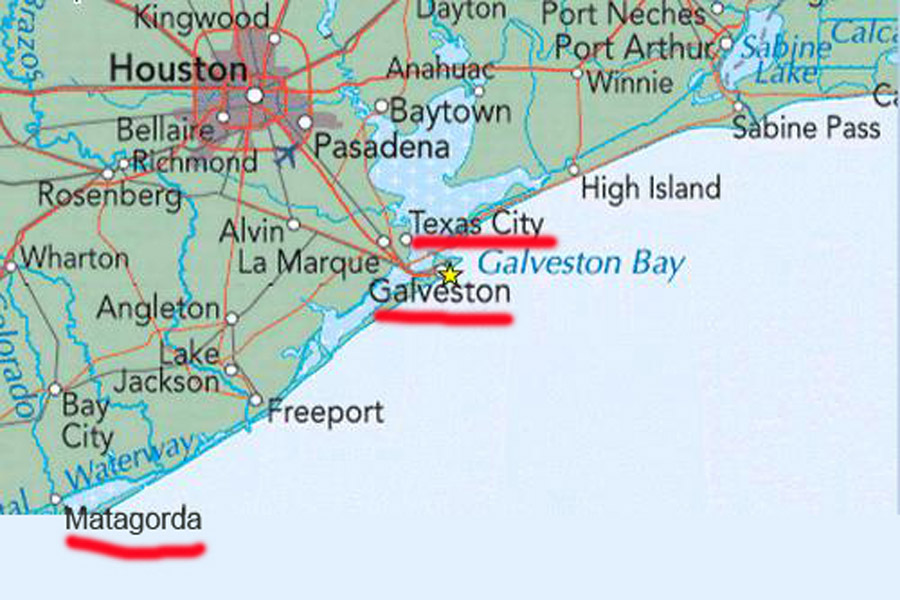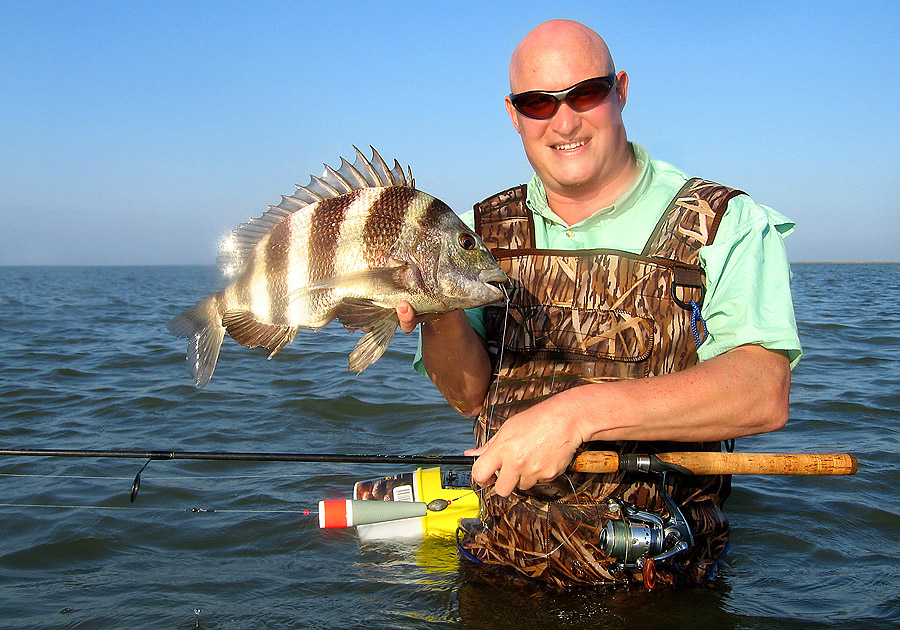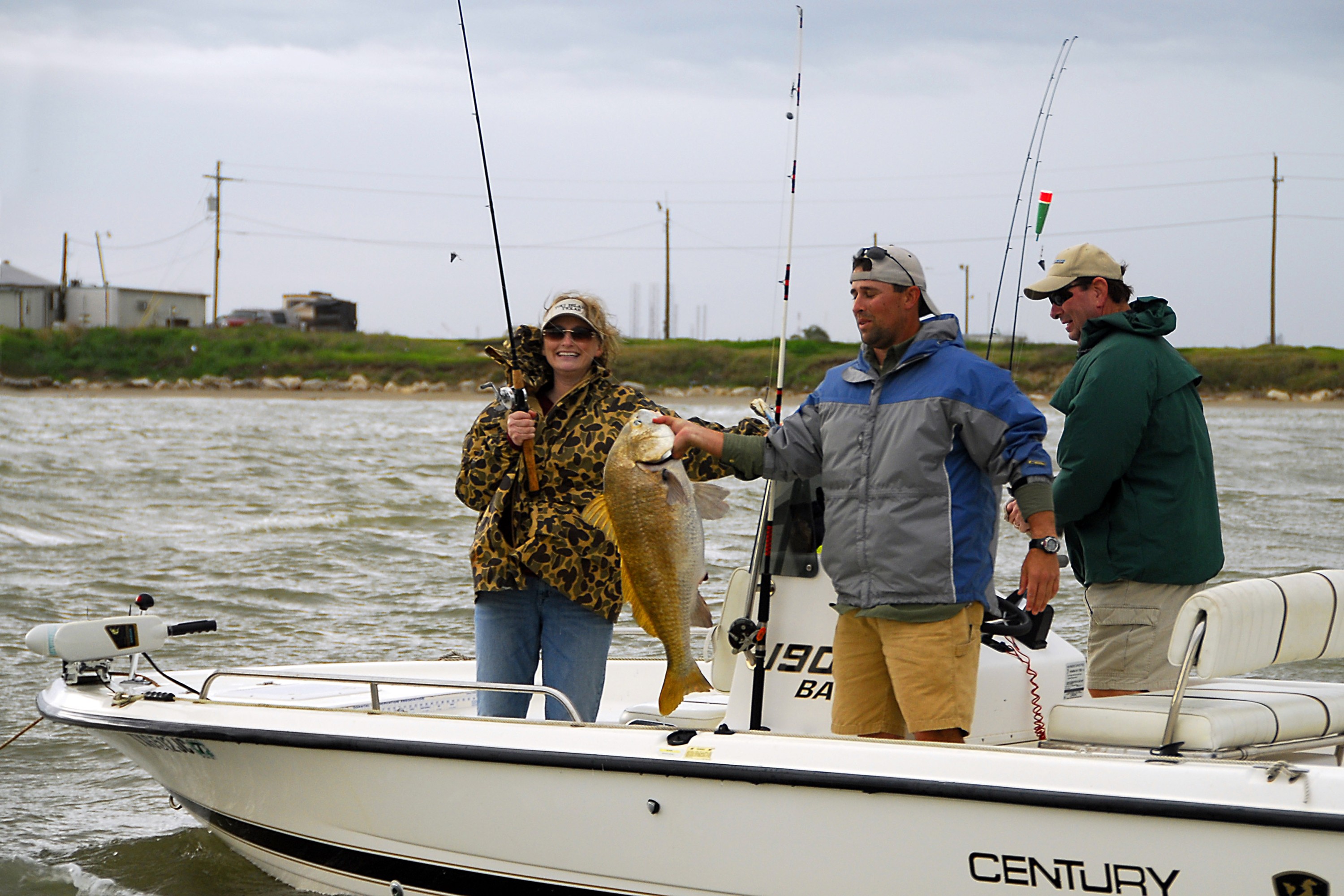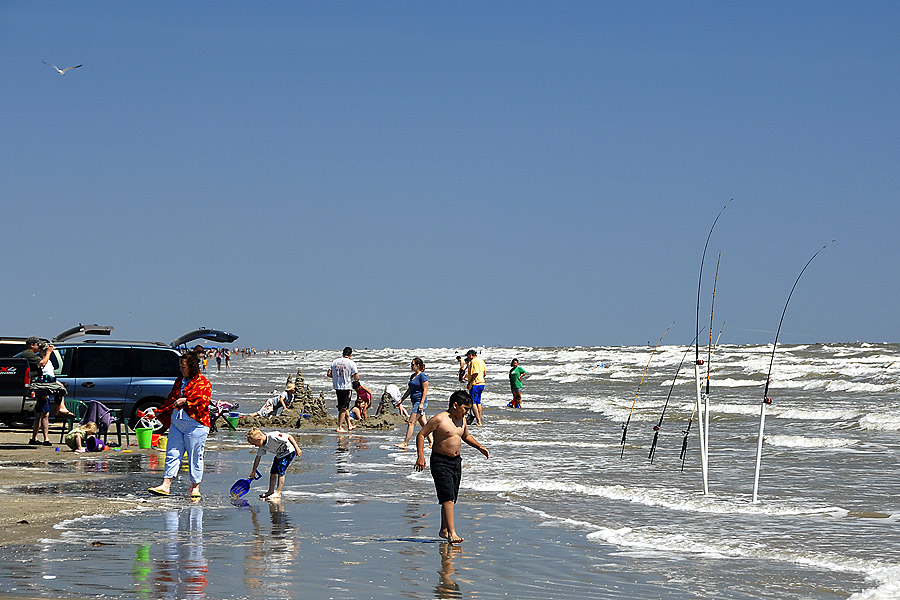 (2007) The month of March on the Texan coast is a bit chilly, at least if you ask the locals. We had 24-27 degrees every day, quite a few clouds, and the water was over 18 degrees warm. To me, it sounds more like a summer vacation. Kirk, who is usually our alligator gar guide, had promised me, and our English friends, Steve and Mark, a slightly different fishing trip to Texas, namely coastal fishing for redfish.
(2007) The month of March on the Texan coast is a bit chilly, at least if you ask the locals. We had 24-27 degrees every day, quite a few clouds, and the water was over 18 degrees warm. To me, it sounds more like a summer vacation. Kirk, who is usually our alligator gar guide, had promised me, and our English friends, Steve and Mark, a slightly different fishing trip to Texas, namely coastal fishing for redfish.
Wading in Matagorda Bay
Kirk had arranged with a wanna-be fishing guide, Don, to take us out and wade fish in Matagorda Bay, which is situated southwest of Houston. Don is an incarnated redneck (he agrees), completely as you would expect to see in a movie; he speaks with the typical Texas drawl, he chews snuff and spits like a cowboy, he drives around in a pickup truck with more weapons than he himself is fully aware of, and then his house looks like a scene in a chainsaw massacre movie.
Matagorda Bay is a shallow area on the inside of some elongated islands in the Gulf of Mexico. In this bay (or bays, because there are several of them) all sorts of exciting fish species move in at different times of the year to spawn and to hunt for food.
The day we were going to fish with Don, he could not get live shrimp where he usually does, so we had the pleasure of his jokes, fishing stories, country music and farts for a few hours as we drove to another shop to get them. But after that all went smoothly. We had breakfast in the tackle shop in Matagorda harbour, after which the boat was lowered into the water and we sped out into the sunny bay. His boat is one of the typical flats boats with low sides. A 175 hp engine had been slapped on (yes, the boat engines are also bigger over there), and he drove the boat as if the engine setting was digital, meaning that the boat either lay still or drove at full speed, nothing in between.
We started fishing at an oyster reef that was partially populated by pelicans. This was in itself reasonably exotic, you just do not want to fall here, because you will be cut to ribbons by the sharp shells. We waded out into the nice warm water and were told to drag our feet as there are many stingrays in the bay. These stingrays (Hypanus/Dasyatis sabina) are not particularly large, but several anglers got holes in their legs and feet, and an unfortunate guide has even had his Achilles tendon cut in two, which he never recovered from.
 The gear consisted of regular spinning rods rigged up with popper floats and a small treble hook, where one of the hooks is put through the shrimp's head just below its powerful forehead spear. We kept the live shrimp in some practical plastic buckets with holes in them, specially designed for the purpose.
The gear consisted of regular spinning rods rigged up with popper floats and a small treble hook, where one of the hooks is put through the shrimp's head just below its powerful forehead spear. We kept the live shrimp in some practical plastic buckets with holes in them, specially designed for the purpose.
The technique is to cast out, pop a few times, and then let the bait lie for a few minutes; popping a few times again, etc ... The popping sound attracts the predatory fish, and in our case primarily redfish, black drum and spotted weakfish, which are the favourite species of the local anglers. The drumfish (Sciaenops ocellatus & Pogonias cromis) can both grow to weigh over 45 kg, and are often caught around 20 kg, and the coveted spotted weakfish (Cynoscion nebulosus), locally named seatrout, can weigh up to 8 kg and is usually caught at 1 to 4 kg.
We caught lots of redfish weighing up to 4 kg, some small black drumfish, and a few weakfish to 2 kg. Unfortunately, we all lost the larger drumfish, we hooked.
As a kind of compensation, we got quite a few great side catches, for example sheep's head sea bream (Archosargus probatocephalus) of about 3 kg that fought fiercely.
We all caught the common sea catfish (Ariopsis felis), which is considered by the locals to be a plague. They snatch the bait from more exciting fish species; they have sharp fin rays and poisonous mucus, which is an unfortunate combination should you get stung.
We also got a pair of the infamous stingrays. As I said, the Florida stingray will not grow very big, max 5 kg and approximately 60 cm in diameter, but I still thought they were fun to catch.
We asked Don if there were any sharks there and he said that it was not exactly the season but that in the summer period there are many bull sharks (Carcharhinus leucas). He told us that even though sharks do not specifically target humans, it is somewhat scary to have 2-3 meter long sharks around you while standing in the water and fishing. He once experienced a bull shark of a couple meters trying to snatch his catch of weakfish, threaded on a metal ring attached to his belt. The shark pulled hard on the fish, so much so that throw the fishing rod and knock the fish on the head with his fists before he could release the belt and the shark bolted off with the catch.
 Boat fishing at the Texas City dike
Boat fishing at the Texas City dike
The Texas City dike is a favourite destination for local anglers and families who picnic from the backs of their large trucks, and there were plenty of them on the weekends. They were parked side by side all the way on the 6 km long stone dike. At the end of the dike there is a bridge on wooden poles where one can also fish from, and even at night under floodlights.
Kirk brought his own boat on a trailer so we could explore and fishing a little better. Unfortunately, it was quite windy the days we fished from boat, so it was hard to get to fish where we wanted. We tried fishing out at the end of the dike where another boat landed a big black drum while we were there, but there were simply too big waves for it to work properly.
We caught the biggest drums on crab. We only got some small redfish and a single topsail sea catfish (Bagre marinus), but it is for sure that the place has potential.
You can buy shrimp and crabs in fishing tackle & bait shops right at the entrance to the dike. Guided tours are also advertised here, should that be of interest. It is not uncommon to find tarpon (Megalops atlanticus) and ladyfish (Elops saurus) at the dike.
Beach fishing on Galveston Beach
Galveston is a lively and exotic coastal town, with lots of great restaurants and an impressive beach promenade full of people. We fished from the easternmost part of the beach at something called Apffel Park. During the day, the beach is full of sunbathing guests, and at dusk, the love couples arrive in their cool cars, and… yes, guess for yourself. Just like in American movies.
There was a small crowd of anglers on the beach every day, in the eveings. It was mostly Mexicans who mostly fished from the tailgate of their pickup trucks, and they fished until they had reached their quota according to the fishing license.
In addition to the shrimps which we kept alive in a bucket with an air pump, Kirk caught mullets with the cast net. We used a standard beachcast rig that we bought at the Academy Supermarket in Galveston, sand leads with grab sticks, and circle hooks. It was most often the shrimp that caught fish, but the biggest fell for the mullet pieces. Here it was mostly black drum, some nice redfish, and an infinite number of sea catfish.
Guided fishing trips from Galveston are arranged. The focus is on food fish, such as snappers, but also dorado/Mahi mahi (Coryphaena hippurus) and wahoo (Acanthocybium solandri).
